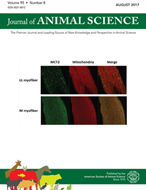-
Views
-
Cite
Cite
P. Mosoni, C. Martin, E. Forano, D. P. Morgavi, Long-term defaunation increases the abundance of cellulolytic ruminococci and methanogens but does not affect the bacterial and methanogen diversity in the rumen of sheep, Journal of Animal Science, Volume 89, Issue 3, March 2011, Pages 783–791, https://doi.org/10.2527/jas.2010-2947
Close - Share Icon Share
ABSTRACT
Protozoa are commensal eukaryotes in the rumen of herbivores. Protozoa are large producers of hydrogen, which is utilized by methanogenic archaea to produce methane, a greenhouse gas. The removal of protozoa from the rumen (defaunation) decreases methanogenesis, but also negatively affects fiber digestion, which is the main function of the rumen. The aim of this study was to examine the effect of long-term defaunation on the structure of the microbiota and particularly methanogenic archaea and fibrolytic bacteria to better understand the microbial mechanisms responsible for the decrease in methanogenesis and fibrolysis. The trial was conducted in 5 adult sheep subjected successively to long-term defaunation (2 yr), refaunation (12 wk), and short-term defaunation (10 wk). Methanogens were enumerated by quantitative PCR targeting the rrs (16S ribosomal RNA subunit) and mcrA (methyl coenzyme-M reductase) genes. The rrs gene was used to quantify the 3 major culturable rumen cellulolytic bacterial species (i.e., Fibrobacter succinogenes, Ruminococcus albus, and Ruminococcus flavefaciens) and total bacteria. Bacterial and methanogen diversity was also examined by PCR-DGGE (PCR-denaturing gradient gel electrophoresis) analysis targeting the rrs and mcrA genes, respectively. Total rumen bacterial density estimated as rrs copies per gram of DM of rumen content increased in response to long- and short-term defaunation (+1 log, P < 0.001), but without noticeable shifts in diversity. Defaunation increased the rrs copies per gram of DM of rumen content of R. albus and R. flavefaciens (+2 log, P < 0 0.001), but did not affect that of F. succinogenes. Despite a 20% reduction in methane emission in the 2 defaunated periods, the mcrA and rrs copies of methanogens per gram of DM of rumen content increased (+1 log, P < 0.001) in the absence of protozoa, whereas the diversity of the dominant methanogenic community was not modified. This study shows no major difference between long- and short-term defaunation in abundance and diversity of bacteria and archaea. It also provides evidence that monitoring the abundance and diversity of methanogens is not sufficient to comprehend the microbial mechanisms leading to a reduction in methane emissions by ruminants. This study also reports for the first time in sheep a selective effect of defaunation on the abundance of cellulolytic bacterial species.





